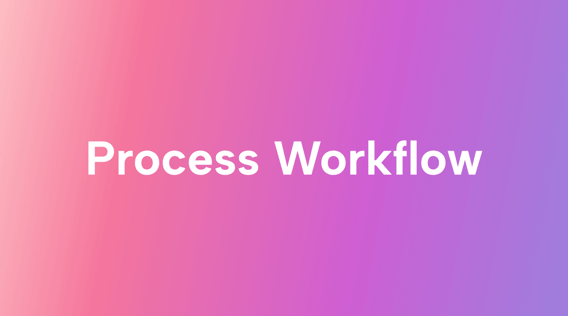Effective teamwork, we understand, is more than the sum of the parts. This is also true of process workflow. While processes and workflows are powerful in their own right, they become even more potent when you use them together.
It helps first to grasp the differences between the two words, often used interchangeably, to understand the true power of this concept. But that’s wrong because one is often a subset of the other: a single business process will usually have many workflows within it.
A practical example is useful. Consider a typical shipping and receiving process workflow, where two main processes are at play: shipping and receiving. Each one contains many workflows.
For instance, the shipping process workflow may include a series of tasks for identifying and commissioning a shipping agent. It could also involve arranging for collection and following up with customers after delivery. These steps could be one workflow or several.
Process vs. workflow
A business workflow can’t exist without a business process to begin with. On the other hand, processes don’t need workflows to exist and frequently contain many interlinked workflows.
What is a workflow?
The best way to understand the concept of a workflow is with an example. Expanding on the one above, a workflow to identify the best shipping agent for a job may involve getting quotes from several shipping agents and deciding according to predetermined criteria.
Your workflow to identify the correct agent would go something like this:
- Build a list of agents represented in the customer’s hometown.
- Filter the list based on experience with individual agents.
Note: A bad previous experience with a particular agent may be a reason to exclude them from the list.
- Create a shortlist of agents to approach for quotations.
- Request quotations from all the agents on the final shortlist.
- Decide based on customer-approved attributes: cost and urgency, for example.
What is a business process?
A business process is an activity or sequence of tasks to achieve a specific organizational objective. Returning to our shipping process example and considering the workflow above to be just one of the workflows in the greater business process.
Assuming that the business process we’re dealing with here is a sales process, other workflows that you may have in your business process could be:
- Sales lead generation
- Sales lead conversion
- Sales order processing
- Order invoicing
- Picking and packing for shipment
- Customer service follow-up
How are they different?
We know that a workflow is a set of steps to achieve a specific business outcome or purpose, for example, generating sales leads. That whole workflow will then be one of the elements of a business process to sell and deliver products to a customer.
But this is where it gets complicated. A single workflow could depend on another workflow's output before it could start. Consider the sales lead conversion workflow listed above: You can’t convert a lead if you don’t already have one, so this workflow depends on the results of the previous one.
Also, multiple business processes may use one workflow. The order invoicing workflow above shows that different divisions might use it to generate customer invoices.
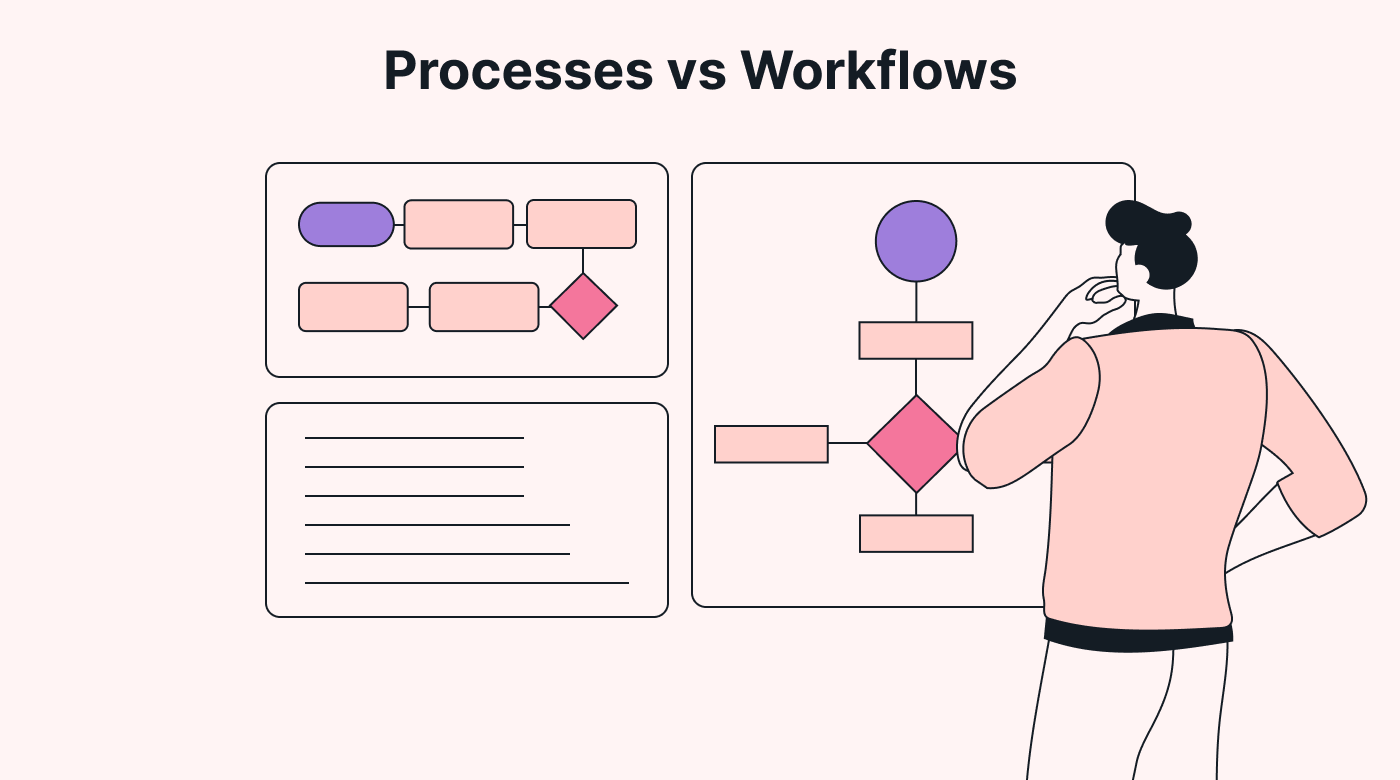 |
Another essential facet of process workflow is business process automation: you’d want to automate everything you can to improve efficiencies. In our example, you may automate lead generation from website queries or automatically generate (and email) a customer satisfaction survey after the shipping contractor has delivered the order.
How to create and document a process workflow
Not surprisingly, to create a process workflow, you must follow a set of steps to build it in a way that achieves an objective and helps your business succeed.
Define the purpose
Creating a workflow starts with a business purpose. Review your business processes to know what needs a workflow, then set your goals. But when you do this, your goals must be SMART — specific, measurable, achievable, relevant, and time-bound.
You need to do this because it’ll help you set clear and actionable objectives, making you more likely to achieve them.
Gather all necessary information
There are several important types of information that you must collect about every process workflow you want to set up:
- What needs to be done
- Who’s involved
- Who has approval rights
Once you have collected this basic information, you can consider the process workflow's details.
Determine the start and end points
The next step would be determining the framework within which the workflow will unfold. Dr. Steven R. Covey’s seminal book, The 7 Habits of Highly Effective People: Powerful Lessons in Personal Change, provides a useful motto, “Start with the end in mind.”
It requires that you pinpoint the start and end points. For example, your starting point could be when a client calls in for a refund, and your process workflow endpoint might be when the refund is either granted or refused. How you move from that start point to the endpoint is what comes next.
Draft the steps and their connections
You have a choice here. Some business owners prepare to start with the desired outcome and work backward, figuring out how to achieve that result. Others prefer to step forward, beginning with what you have at the start and figuring out how to move that to the desired outcome.
It doesn’t matter which way around you prefer to do it as long as, along the way, you figure out all the steps your people need to take, the order they must do them, and what their dependencies are.
Returning to our example, let’s look at the picking and packing process workflow. The start point will be picking the stock listed on the invoice, and the end will be a package ready for shipment. The start point already gives us a dependency: the invoice. We don’t know what to pick if we don't have it. At a high level, your full workflow might look something like this:
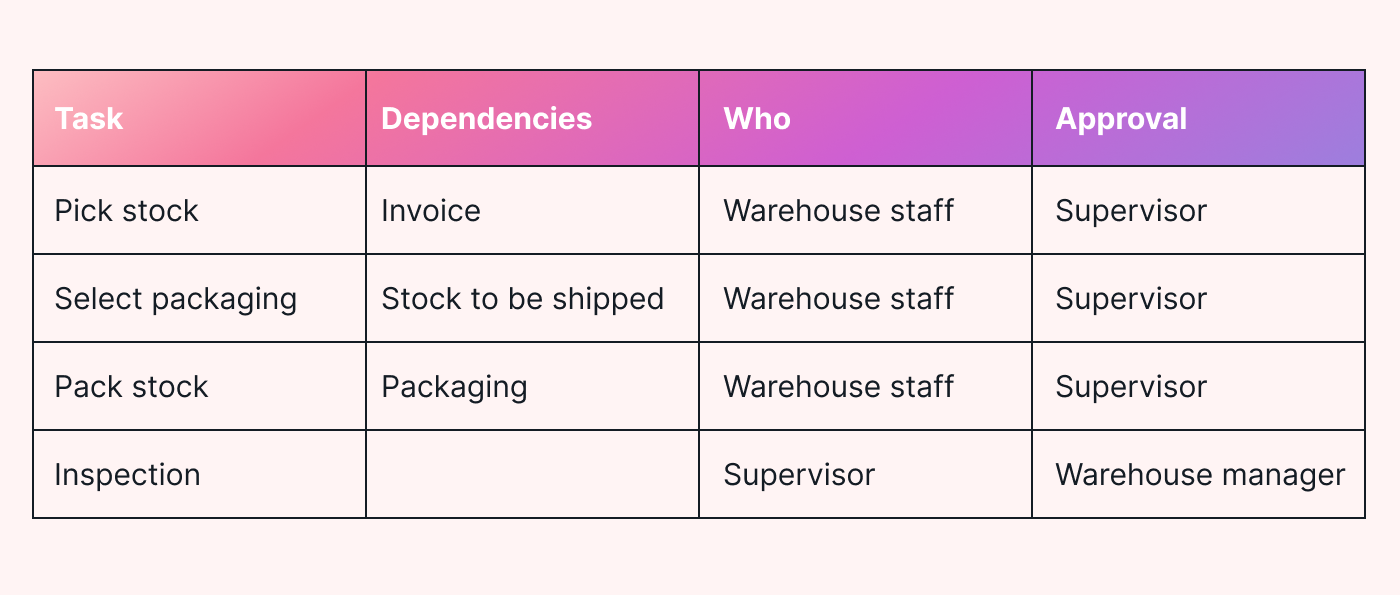 |
Document the process workflow
Humans are known to respond better to visual stimuli than to text. This is why you should map out your processes and workflows in diagrams rather than bulleted lists. And on that score, you’re spoiled for choice: You could use many different types of diagrams to represent how sequential tasks flow from one to another visually.
But that’s where it can get tricky: What kind of diagram? There are many kinds, and you should choose your diagram according to:
- How simple or complex is the workflow?
- How many people are involved?
- How many steps are there?
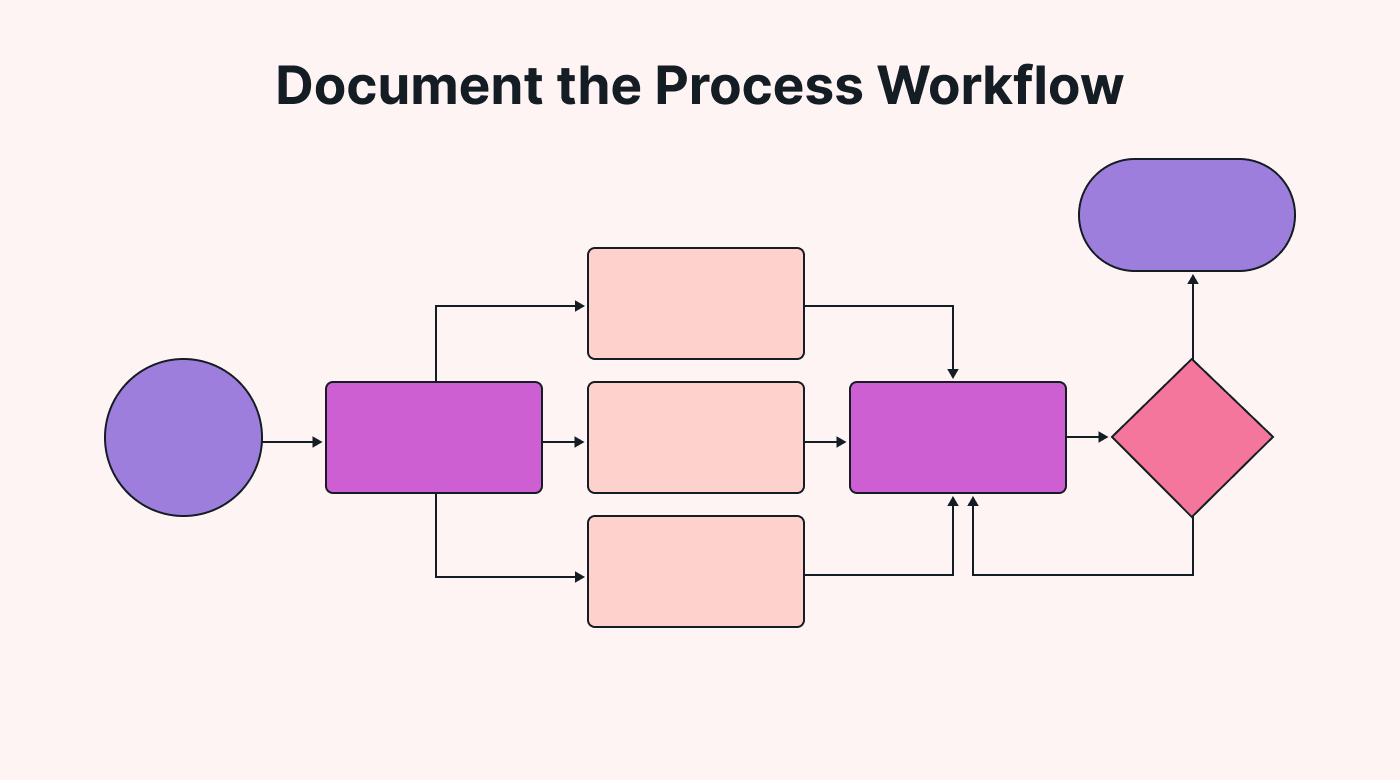 |
Process and workflow diagrams
BPMN
One popular type of workflow diagram is the business process modeling notation (BPMN). This standardized notation uses symbols and shapes to represent different types of tasks, decisions, and flow control mechanisms. The notations are separated into four categories for diagramming:
- Flow objects, such as events, activities, and gateways, define a process.
- Connecting objects connect flow objects like message flows, sequence flows, and associations.
- Swimlanes separate one set of activities from others, such as pools and lanes.
- Artifacts are used for supplemental information about the process.
BPMN provides a clear and concise way to depict complex business processes and is widely used in process modeling and workflow optimization.
Flowcharts
A kind of workflow diagram that’s most commonly associated with programming and data processing is the flowchart. It’s similar to BPMN in that flowcharting uses various symbols to represent different tasks, decisions, and connections between individual tasks.
However, it’s both more restricted and more flexible than BPMN. Flowcharts are restricted because there are no agreed-upon modeling rules and symbols. But they’re more flexible for the same reason: You can use any symbols you like and even create new ones to get your messages across.
This makes them well-suited to documenting and analyzing complex business processes because they provide a comprehensive overview of the process flow.
Activity diagrams
The Activity diagram is another type of workflow diagram often used in software development. Created using the Universal Modeling Language (UML), they show the flow of actions and activities performed in a software system or application.
These diagrams are particularly useful for modeling the dynamic aspects of a system. They’re also one of many diagram types you can create using UML:
- Sequence diagram
- Class diagram
- Use Case Diagram
- Activity diagram
- Component diagram
- Object diagram
- Deployment diagram
- Package diagram
- Communication diagram
- Composite structure diagram
- Timing diagram
- Interaction overview diagram
- State Machine diagram
- Profile diagram
SIPOC diagrams
When you need to map the entire value chain, you might prefer a SIPOC diagram. This is a good choice when you’re looking for a high-level overview of business processes and workflows.
SIPOC diagrams identify the key elements of the process from which they derive their name: suppliers, inputs, process steps, outputs, and customers. They provide a simple and effective way to understand and communicate the overall structure of a business process.
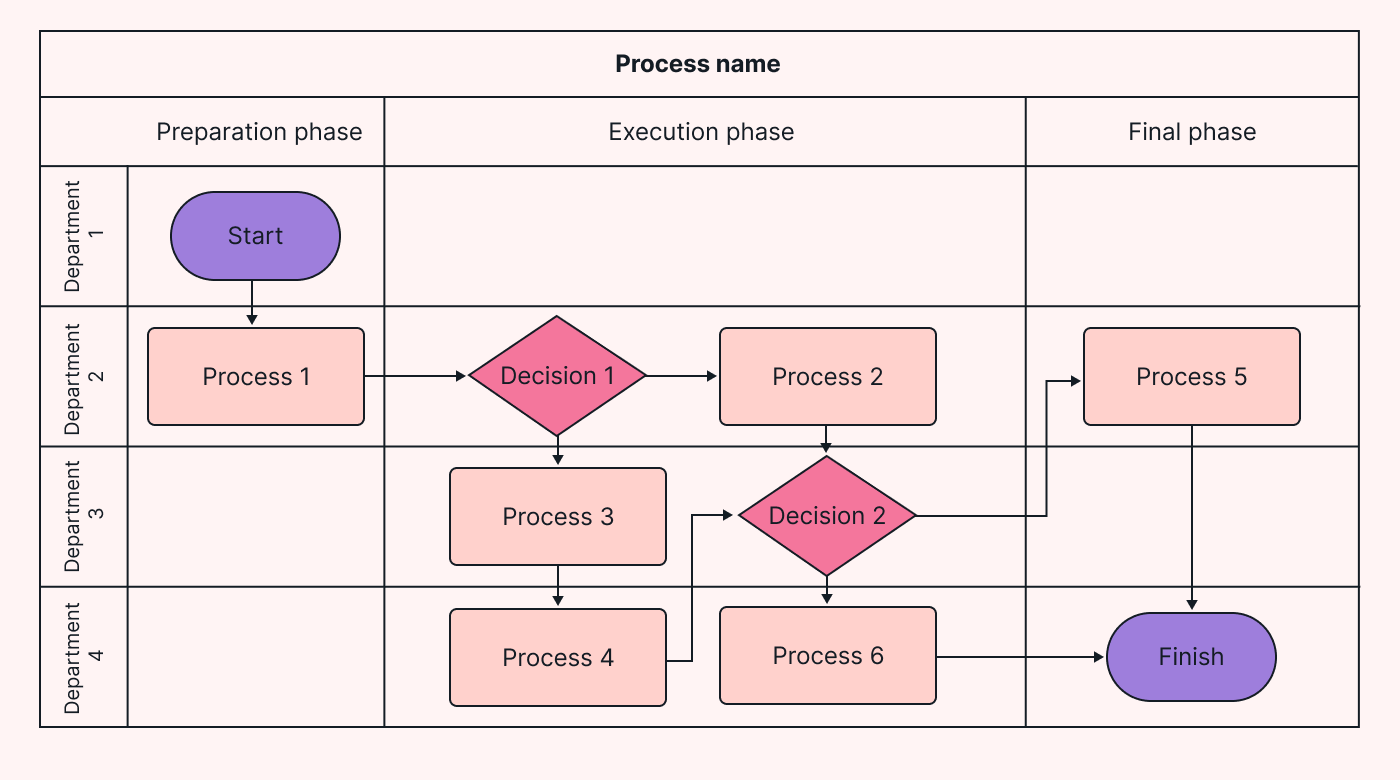 |
Their primary benefits are in how they define and communicate the scope and goals of your process workflow and help you understand its current state. They allow you to identify and prioritize any opportunities and challenges while keeping stakeholders in the loop and involved.
Swimlane diagrams
Sometimes, you want to organize tasks and activities into separate “swimlanes” or categories, which is where this type of diagram comes in handy. Each swim lane represents a different role, department, or function within the organization, and tasks are allocated accordingly.
These diagrams are particularly useful for visualizing and managing cross-functional processes. They also identify who owns each part of a process and show the communication lines, connections, and handoffs between team members.
The primary benefit of this functionality is that it helps to provide a detailed overview of your process workflow and highlight probable inefficiencies.
Automate your process workflows
A process workflow diagram helps you see a flow from beginning to end and clarifies how manual tasks and repeatable activities progress. But without workflow automation, all the tracking and updating must be done manually, which can introduce avoidable delays.
Automating workflows is beneficial because it allows you to optimize your business operations and improve communication. Today’s technology will let you automate complex workflows with easy-to-use drag-and-drop functionality.
As a bonus, many of these tools include artificial intelligence (AI) technology. This gives them even greater efficiency and enables them to help you to:
 |
- Save time by automating all the tedious, repetitive tasks in your workflows.
- Reduce the likelihood and frequency of human errors throughout your business.
- Streamline and integrate your approvals into the workflow, and set triggers for automatic reporting on progress and status updates.
- Manage multiple workflows at once without losing track of overall progress.
- Increase employee buy-in and accountability by making their work easier to do and more fluid in nature.
Path forward with process workflows
Ensuring your business’s future success means having repeatable process workflows, which is essential if you want consistently positive results. And while finding opportunities for automation is optional, it’s highly recommended to ensure there are fewer loose ends in the flow.
As a business owner or team leader, you know how important it is to keep track of all activities and to accomplish goals effectively. When you integrate clear process workflows that even new employees can follow, you’re setting yourself up for success.
And it’s a lot easier than you may think to accomplish all your business goals. Let Motion’s AI-powered calendar help you build your team’s schedules to design or revise processes and attach your diagrams to the new tasks and scheduled sessions.

